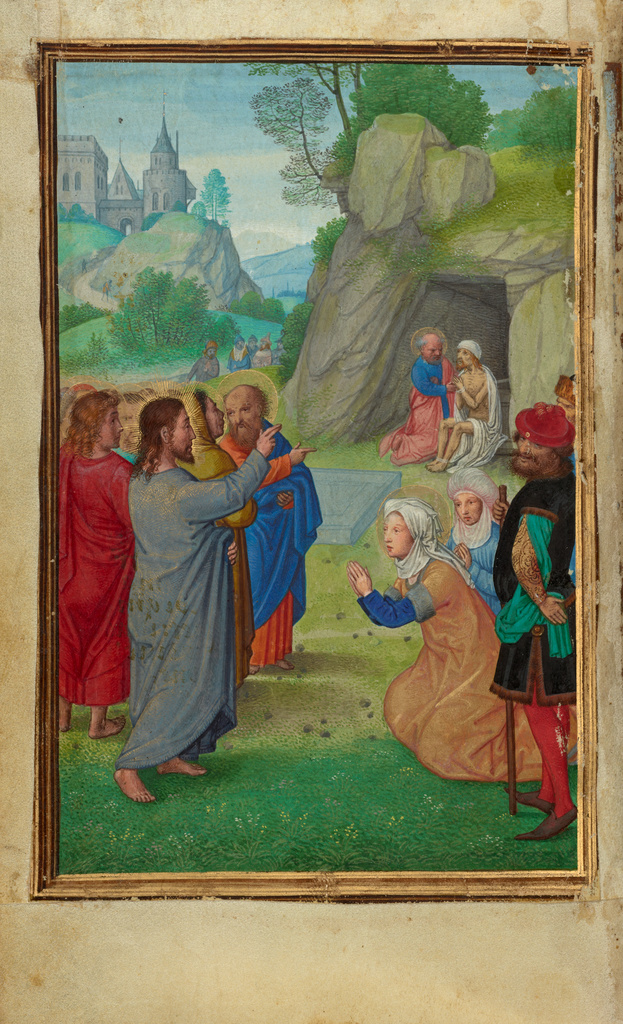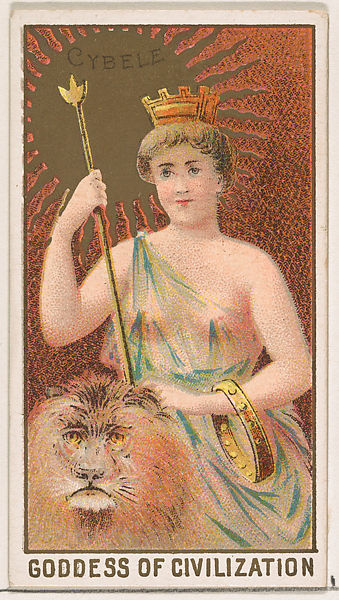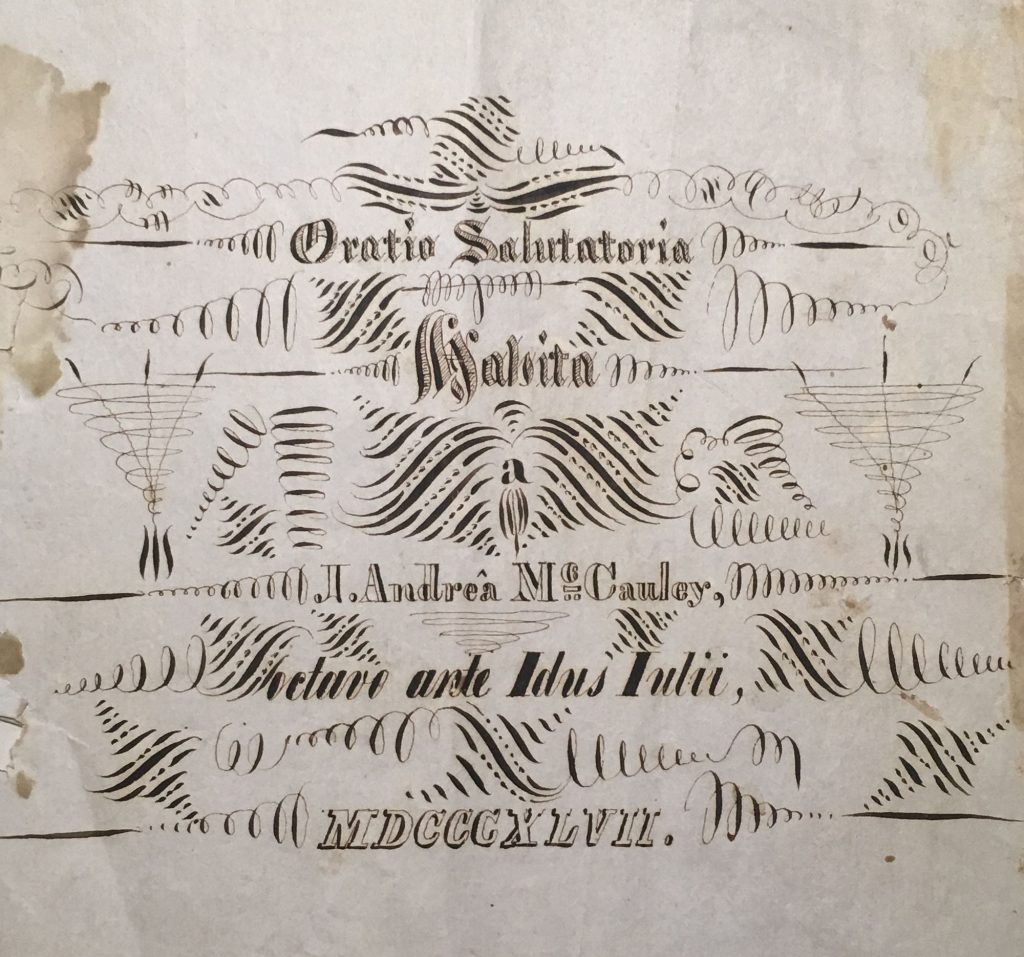Elizabeth Jane Weston (1582-1612) was one of the most accomplished Latin poets of the early modern period. Among her published works is a collection of Aesopic fables rendered into Latin elegiac couplets. Katrina Faulkner (Dickinson ’23) reads, translates, and discusses one of them here, “The Pidgeon and the Painting,” comparing it to Greek and Medieval Latin versions of the same fable.
Columba et Tabula Picta (The Pidgeon and the Painting)
From Elizabeth Jane Weston, Parthenica (Prague: Paulus Sessius, ca. 1606) vol. 2, fol. B6a.
Ex nimio multum sitiens ardore columba
viderat appensam parietibus tabulam,
hydria qua fuerat tam vivo picta colore,
et specie falsum dissimulante liquor.
Unde sinistra suis circumdans pocula pennis,
optatae infelix approperavit aquae.
Et pictam contra praeceps allapsa tabellam,
collisā periit praecipitata gulā.
A dove who was thirsting greatly from excessive heat had seen a painted tablet hanging on a wall, where a water jug had been painted with very vivid color, and counterfeit liquid with a deceptive appearance. And so, wrapping around the injurious cup with her wings, the unfortunate dove flew toward the desired water. And flying headlong against the painted tablet, she perished, having collided at high speed, her throat crushed.
Vocabulary & Notes
sitiens, sitientis: thirsty
ardor, ardoris, m: heat, burning heat.
columba, columbae, f.: a dove, a pigeon.
appendo, apprendere, appendi, appensum: to hang something upon something, to suspend on.
paries, parietis, m.: a wall.
tabula, tabulae, f.: a painted tablet or panel, a painting, a picture.
hydria, hydriae, f.: a water-pot or a jug.
qua: on which side, at or in which place, in what direction, where, by what way, i.e. qua hydria, “where a jug…”
vīvus, vīva, vīvum: lively, vivid.
pingo, pingere, pinxi, pictum: to paint, stain, color.
dissimulo, dissumulavi, dissimulatum: to feign that a thing is not that which it is; to dissemble, disguise; to hide, conceal, keep secret.
liquor, liquōris: a fluid, a liquid
sinister, sinistra, sinistrum: unlucky, injurious, adverse, unfavorable, ill, bad
circumdo, circumdare, circumdedi, circumdatum: to put, set, place, or wrap around.
poculum, poculi, n.: a drinking vessel, a cup, goblet, bowl, beaker.
penna, pennae, f.: a wing.
opto, optāre, optāvi, optātum: to choose or select
infelix, infelīcis: unfortunate, unhappy, miserable.
appropero, approperāre, appropāvi, apprropātum: to hasten, accelerate or to fly, to hurry somewhere.
praeceps, praecipitis: headlong, hasty, rash, precipitate.
allabor, allabi, allapsus sum: to glide to or toward something, to come to, to fly, fall, slow, slide, and the like
tabella, tabellae, f.: a painted tablet, a small picture or painting.
collīdo, collīdere, collīsi, collīsum: to clash, strike, dash, beat, or press together
praecipito, -āre, praecipitavi, praecipitatum: to hasten or rush down, to throw oneself down, rush headlong, sink rapidly, to fall, i.e. at high speed.
gula, gulae, f.: the gullet, throat.
Similar Aesopic Fables
ΠΕΡΙΣΤΕΡΑ ΔΙΨΩΣΑ (The Thirsty Pidgeon)
From K. Halm, Fabulae Aesopicae Collectae (Leipzig: Teubner, 1854) #357, p. 176.
περιστερὰ δίψει συνεχομένη ὡς ἐθεάσατο ἔν τινι πίνακι κρατῆρα ὕδατος γεγραμμένον, ὑπέλαβεν ἀληθῆ εἶναι. διόπερ πολλῷ ῥοίζῳ ἐνεχθεῖσα ἔλαθεν ἑαυτὴν τῷ πίνακι ἐντινάξασα. συνέβη οὖν αὐτῇ τῶν πτερῶν περιθραυσθέντων ἐπὶ τὴν γῆν καταπεσοῦσαν ὑπό τινος τῶν παρατυχόντων συλληφθῆναι.
οὕτως ἔνιοι τῶν ἀνθρώπων διὰ σφοδρὰς ἐπιθυμίας ἀπερισκέπτως τοῖς πράγμασιν ἐπιχειροῦντες ἑαυτοὺς εἰς ὄλεθρον ἐμβάλλουσιν.
A pigeon distressed by thirst, when she saw a water bowl depicted on a tablet of wood assumed that it was genuine. And so, rushing at it with high speed, she unintentionally smashed into the painted tablet. Thus, with her wings having been broken, she fell to the ground and was captured by a passerby.
Thus, some people, because of intense desires, thoughtlessly embark on affairs and hurl themselves into destruction. [trans. Christopher Francese]
Columba et Hydria Picta (The Pidgeon and the Painted Water Jar)
From Laura Gibbs, Mille Fabulae et Una: 1001 Aesop’s Fables in Latin (Morrisville, NC: Lulu Publishers, 2010), #512, p. 163.
Columba, siti compulsa, aquam ut inveniret, huc illuc ambulaverat. Conspecta deinde picta in pariete hydria, vas aqua plenum se invenisse credens, celeri impetu petiit potum. Sed semianimis illisa parieti concidit humi. Morti ergo vicina, sic secum locuta est, “Infelix ego et misera, quae, aquae nimis appetens, non cogitaram vitae periculum.”
A pigeon, having been compelled by thirst, had traveled to and fro so that she might find water. Finally, with the water pitcher painted on the wall having been seen, believing that she had found a vessel full of water, she thrust at the drink with a quick charge. But having collided with the wall she fell down to the ground half-alive. Therefore, with death close, she spoke to herself as follows, “I am a wretch and miserable, who, excessively greedy for water, had not considered the danger to my life.”
Discussion
Elizabeth Jane Weston’s fable, “Columba et Tabula Picta” or “The Pigeon and the Painted Tablet,” follows a similar course as other fables in the Aesopic tradition, including “The Pigeon and the Water Jug Painting” or “Columba et Hydria Picta” and “The Thirsty Pigeon” or “Περιστερᾶ διψῶσα.” While it is unknown what specific texts Weston used as source material it is clear that she had access to at least one previously existing version of this fable. Each of these three fables follows a thirsty pigeon in search of water who encounters a painting of a water jug and believes it to be legitimate. All three result in the same tragic ending: the pigeon crashes into the painting, painted on a solid wooden tablet, and perishes upon impact.
Both Latin versions, Elizabeth Jane Weston’s “Columba et Tabula Picta” as well as that from Syntipae Philosophi Persae Fabulae, “Columba et Hydria Picta,” differ somewhat from the Ancient Greek version. Notably, the Greek version ends with the pigeon being captured by a human passerby. Further, the Greek version provides a distinct moral at the end: “Thus, some people, because of intense desires, thoughtlessly embark on affairs and hurl themselves into destruction.” Similarly, “Columba et Hydria Picta” ends with the moral more directly implied than seen in Weston’s fable, having the pigeon speak her final words which convey the ultimate meaning of the fable. Weston’s fable shies away from the direct providing of meaning and moral, though indirect, it is still apparent.
The Greek version, “Περιστερᾶ διψῶσα”, places emphasis on foresight, with the pigeon’s thoughtlessness being her downfall, conveying a moral against thoughtless pursuit of desires. “Columba et Hydria Picta” places special emphasis on greed, with the pigeon describing herself as “nimis appetens” meaning “excessively greedy,” and also conveys a similar emphasis on thoughtlessness, “non cogitaram vitae periculum” meaning “I had not considered the danger to my life”. Similar to “Columba et Hydria Picta,” Weston uses “nimio,” in this case paired with “ardore” meaning “excessive heat”. Weston’s use of nimio seems to portray the pigeon’s harsh conditions rather than portray her intense greed. Much of her fable places particular emphasis on the deception of the painting, saying “specie falsum dissimulante liquor” (liquid with a disguising appearance, a forgery) and “sinistra…pocula” meaning “injurious cup” or as Cheney translates, “false cup.” This seems to shift the blame away from the bird and onto the false image. Weston’s version seems to lack the same level of condemnation of foolishness and thoughtlessness that is present in both other versions. That said, the fable still ends with the death of the pigeon, implying a definite moral backing. Further, Weston’s depiction of the pigeon’s death could be considered the most gruesome of the three. The Greek text implies the death as the bird is carried off by a passerby, the alternative Latin text describes death approaching “Morti ergo vicina” and ends with the pigeon’s last words. Weston’s version instead describes the pigeons throat, “gulā,” being crushed upon impact with the painting. Weston’s text still seems to, much like the other two versions, emphasize the desire of the pigeon. With “optatae aquae” (the desired water), Weston directly references the idea of desire and denounces greed. Further, with “praeceps” meaning “headlong,” “hasty,” or “rash,” Weston conveys the thoughtlessness of the pigeon. Weston’s “Columba et Tabula Picta” conveys a message promoting self-restraint and modesty as well as denouncing greed.
Elizabeth Jane Weston wrote for the upper class; thus, her fate was in their hands. She had first-hand experience with the ups and downs of court life with her stepfather having been a controversial figure and falling out of favor. Her speech given to Lord Heinrich von Pisnitz for his birthday shows her applying this principle of modesty and restraint which she preaches. Weston was well aware that her station was not secure and was nervous of being seen as greedy by those who helped her, lest they cease their patronage. This fable is especially cognizant of this as it warns against striving above your station and puts forth morals of modesty and restraint. Interestingly, this fable, in all three versions, seems especially targeted towards the lower classes with the pigeon struggling and the message meaning to suppress attempts to quench that suffering. Yet “Columba et Tabula Picta”, as with all of Weston’s writing, was targeted towards the upper classes. Perhaps it was meant to concur with upper class sentiments, those which likely wanted to maintain their social standing and therefore suppress those below them or perhaps the fable was simply written in order to reinforce Weston’s modest depiction of herself to her patrons. Elizabeth Jane Weston is perceived by historians to have been an especially ambitious figure. It seems that the other two variations of this fable warn distinctly against ambition, or at the very least against ambition without careful thought to drive it. Weston’s version, with more emphasis on the falsehood that is the image, seems to have a further warning against striving for that which one does not fully understand, rather than simply advising against ambition as a whole. Further, rather than wholeheartedly attacking ambition, Weston uses “Columba et Tabula Picta” more so to condemn greed.
Works Cited
Cheney, D., B. Hosington, and D. Money. Elizabeth Jane Weston: Collected Writings. Toronto: University of Toronto Press, 2000.
Gibbs, L. Mille Fabulae et Una: 1001 Aesop’s Fables in Latin. Morrisvill, NC: Lulu Publishers, 2010.
Halm, K. Fabulae Aesopicae Collectae. Leipzig: Teubner,1852.
Matthaeus, C.F. Syntipae Philosophi Persae Fabulae. Leipzig: Christiani Rudiger 1781.
This edition was completed as the final project for Latin 234: Ovid, taught by Christopher Francese in Spring 2021. Prof. Francese modernized the Latin orthography.




